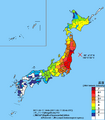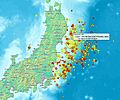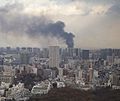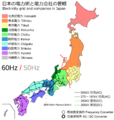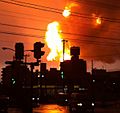2011 Tōhoku earthquake and tsunami facts for kids
| 東北地方太平洋沖地震 東日本大震災 |
|
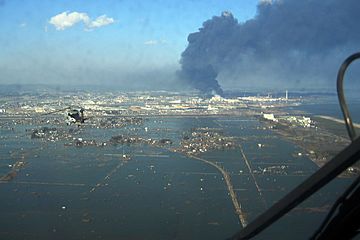
A helicopter flies over the port of Sendai to deliver food to survivors of the earthquake and tsunami.
|
|
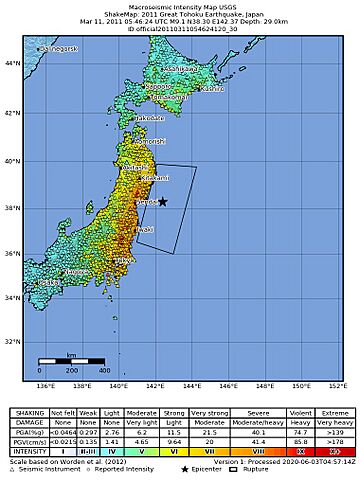 |
|
| UTC time | 2011-03-11 05:46:24 |
|---|---|
| ISC event | 16461282 |
| USGS-ANSS | ComCat |
| Local date | 11 March 2011 |
| Local time | 14:46:24 JST |
| Duration | 6 minutes |
| Magnitude | 9.0–9.1 Mw |
| Depth | 29 km (18 mi) |
| Epicenter | 38°19′19″N 142°22′08″E / 38.322°N 142.369°E |
| Fault | Convergent boundary between Pacific plate and Okhotsk microplate |
| Type | Megathrust |
| Areas affected |
|
| Total damage | US$360 billion (equivalent to $468.3 billion in 2022) |
| Max. intensity | JMA 7 |
| Peak acceleration | 2.99 g |
| Peak velocity | 117.41 cm/s |
| Tsunami | Up to 40.5 m (133 ft) in Miyako, Iwate, Tōhoku |
| Landslides | Yes |
| Foreshocks | List of foreshocks and aftershocks of the 2011 Tōhoku earthquake |
| Aftershocks | 13,386 (as of 6 March 2018[update]) |
| Casualties |
|
On March 11, 2011, a very powerful undersea earthquake struck off the coast of Japan's Tōhoku region. This earthquake, one of the strongest ever recorded, lasted about six minutes. It caused a massive tsunami, a series of giant ocean waves, that crashed onto Japan's eastern coast. Many towns were destroyed, and sadly, many lives were lost. The tsunami also led to serious problems at the Fukushima Daiichi nuclear power plant, where reactors were severely damaged, and radioactive materials were released, causing many people to evacuate their homes. This event is often called the "Great East Japan Earthquake" and is remembered as one of the most expensive natural disasters in history.
The earthquake was the most powerful ever recorded in Japan. It was also the fourth most powerful earthquake recorded in the world since 1900. The tsunami waves reached heights of up to 40.5 metres (133 ft) in Miyako, Iwate. In the Sendai area, the waves traveled at 700 km/h (435 mph) and went up to 10 km (6 mi) inland. Residents in Sendai had only eight to ten minutes to prepare. Over a hundred evacuation sites were washed away. Cold weather and snowfall made rescue efforts very difficult.
The tsunami caused the Fukushima Daiichi nuclear disaster. This included severe damage to three of its reactors. It also led to the release of radioactive water and forced hundreds of thousands of residents to evacuate. Many power generators stopped working. The loss of electricity meant cooling systems failed, causing heat to build up. This heat created hydrogen gas, which exploded and damaged parts of the plant. People living within a 20 km (12 mi) radius of the Fukushima Daiichi plant had to leave their homes.
The total economic damage was estimated at over $300 billion. This made it the costliest natural disaster in history.
Contents
Understanding the 2011 Tōhoku Earthquake
The magnitude 9.1 undersea earthquake happened on March 11, 2011, at 2:46 PM Japan Standard Time. It occurred in the Pacific Ocean, about 72 km (45 mi) east of the Oshika Peninsula in Tōhoku, Japan. The earthquake lasted for about six minutes. Sendai was the closest major city to the earthquake's center.
Foreshocks and Aftershocks
Before the main earthquake, there were several large foreshocks. A foreshock is a smaller earthquake that happens before a larger one. One major foreshock was a magnitude 7.2 earthquake on March 9. After the main earthquake, thousands of aftershocks followed. An aftershock is a smaller earthquake that happens after a larger one in the same area. Over 800 aftershocks were magnitude 4.5 or greater. These aftershocks continued for years, slowly decreasing over time.
How the Earthquake Happened: Geology
This massive earthquake happened where the Pacific plate is sliding underneath the plate that Japan sits on. This process is called subduction. The Pacific plate moves about 8 to 9 cm (3.1 to 3.5 in) each year. This movement builds up a lot of energy. When the stress becomes too great, the plates suddenly slip. This causes a huge earthquake. The slip made the seafloor rise by several meters. This type of earthquake is called a megathrust earthquake. Scientists were surprised by how strong this earthquake was.
Earthquake Energy and Ground Motion
The energy released by the earthquake's seismic waves was enormous. It was almost double the energy of the 2004 Indian Ocean earthquake. If this energy could be used, it could power a city the size of Los Angeles for a whole year!
The ground shaking was very strong. It reached the highest level, Shindo 7, on Japan's seismic intensity scale in Kurihara, Miyagi. Other areas like Fukushima, Ibaraki, and Tochigi also experienced very strong shaking. Even Tokyo felt strong tremors.
Changes to Earth: Geophysical Effects
The earthquake was so powerful that it moved parts of northeastern Japan by about 2.4 m (8 ft) to the east. It also shifted the Earth's axis by 10 to 25 cm (4 to 10 in). This small shift made Earth's rotation speed up, shortening each day by 1.8 microseconds. The seafloor near the earthquake's center also moved significantly.
In some areas around Tokyo, the ground became like liquid, a process called soil liquefaction. This happened in areas built on reclaimed land. It damaged homes and buildings. A volcano in Kyushu, Shinmoedake, erupted three days after the earthquake. Scientists are not sure if it was linked to the earthquake.
Land Subsidence
The earthquake caused the land along parts of Japan's Pacific coast to sink. This is called land subsidence. For example, the Oshika Peninsula in Miyagi sank by 1.2 meters (3 ft 11 in). This permanent sinking made these communities more likely to flood during high tides.
Early Warning System
Japan has an advanced Earthquake Early Warning system. It uses over 1,000 seismometers to detect earthquakes quickly. One minute before the earthquake was felt in Tokyo, this system sent warnings to millions of people. This early warning likely saved many lives. However, the system initially underestimated the earthquake's strength in some places. This was because very large earthquakes can "saturate" the measurement scales. Japan's Meteorological Agency later updated the system to improve its accuracy and speed for future large quakes.
The Destructive Tsunami
The earthquake caused a huge section of the seabed to rise by 6 to 8 meters (20 to 26 ft). This happened about 60 kilometers (37 mi) offshore. This sudden movement of the ocean floor created a massive tsunami. The tsunami brought widespread destruction along Japan's Pacific coastline. It also traveled across the entire Pacific Ocean, reaching coasts in North and South America. While waves were minor in most distant places, warnings were issued, and evacuations took place in many countries.
Tsunami Impact in Japan
Japan's Meteorological Agency issued its most serious tsunami warning. It predicted waves of at least 3 meters (9.8 ft) high. The tsunami flooded about 561 square kilometers (217 sq mi) of land in Japan.
The tsunami reached Japan's coast about 10 to 30 minutes after the earthquake. At 3:55 PM, the tsunami flooded Sendai Airport, sweeping away cars and planes. Many towns were completely destroyed. For example, Rikuzentakata in Iwate Prefecture was almost entirely wiped out. The tsunami was three stories high there.
One reason for the high death toll was the unexpected height of the waves. Many seawalls, built to protect against tsunamis, were not tall enough. They were built for smaller, more common tsunamis. Many people also thought they were on high enough ground to be safe. After the disaster, experts recommended building taller seawalls and teaching citizens better evacuation plans for very large tsunamis.
The highest recorded tsunami run-up (how far up a slope the water goes) was 40.1 meters (132 ft) at Ryōri Bay in Ōfunato. In Miyako, it reached up to 40.5 meters (133 ft). These heights were among the highest ever recorded in Japan.
A Japanese government study found that 58% of people in coastal areas who heard tsunami warnings immediately went to higher ground. Of those who evacuated, only five percent were caught by the tsunami. This shows how important early warnings and quick action are.
Tsunami Effects Across the Pacific
The tsunami traveled across the Pacific Ocean. Russia evacuated 11,000 residents from its Kuril Islands. In California and Oregon, waves up to 2.4 m-high (7.9 ft) damaged docks and harbors. Hawaii also saw significant damage to public and private properties.
On Midway Atoll, a 1.5 m-high (4.9 ft) wave submerged reef inlets and an island. This sadly killed over 110,000 nesting seabirds. Other Pacific countries like Tonga and New Zealand experienced larger-than-normal waves but no major damage.
Along the coasts of Mexico and South America, tsunami surges were reported. Peru reported a 1.5 m (4 ft 11 in) wave, damaging over 300 homes. Chile experienced waves up to 3 m (9.8 ft), damaging more than 200 houses. Even the Galápagos Islands saw a 3 m (9.8 ft) surge.
The tsunami was so powerful that it broke icebergs off the Sulzberger Ice Shelf in Antarctica, 13,000 km (8,100 mi) away. The largest iceberg was about the size of Manhattan Island.
Seiches in Norway
On the day of the earthquake, the waters in several fjords in Norway appeared to "boil" and formed waves. This phenomenon, called a seiche, was caused by the earthquake's seismic energy traveling thousands of kilometers.
Casualties and Human Impact
The official figures released in 2021 reported 19,759 deaths, 6,242 injured, and 2,553 missing people. The majority of those who died were over 60 years old.
Many deaths were also indirectly related to the disaster. These included deaths from physical and mental fatigue caused by living in temporary shelters or from delayed medical treatment. Most of these indirect deaths occurred in Fukushima Prefecture, possibly due to the stress of evacuations caused by the nuclear disaster.
The disaster deeply affected children. As many as 100,000 children were displaced from their homes. Some were separated from their families because the earthquake happened during the school day. Over 230 children were orphaned, and 1,580 lost one or both parents.
Damage and Effects
The earthquake and tsunami caused immense damage. Most of the destruction came from the tsunami. Video footage showed entire towns reduced to rubble. Japan had invested billions in seawalls, but the tsunami simply washed over them or collapsed them.
Japan's National Police Agency reported that over 45,700 buildings were destroyed and 144,300 were damaged. Roads, railways, and other infrastructure suffered heavy damage. Fires broke out in many areas. The Japanese Prime Minister called it the toughest crisis for Japan since World War II. About 4.4 million homes lost electricity, and 1.5 million lost water.
Weather Conditions
Cold temperatures and snowfall made the situation much worse. Snow fell in many tsunami-hit areas, including Ishinomaki, where temperatures were around 0 °C (32 °F). This severely hampered rescue efforts.
Waste and Debris
The tsunami generated huge amounts of debris, estimated at 24–25 million tons. Much of this waste, especially plastics, washed up on the coasts of Canada and the United States years later. This increased litter and potentially carried new species to those shores.
Ports and Transportation
All of Japan's ports were temporarily shut down. Fifteen ports in the disaster zone were severely damaged, including Hachinohe, Sendai, and Ishinomaki. However, all 15 ports reopened to limited ship traffic by March 29, 2011.
Japan's transport network also faced major disruptions. Many sections of the Tōhoku Expressway were damaged. All railway services in Tokyo were suspended, stranding thousands of commuters. Sendai Airport was flooded and severely damaged. However, an early warning system automatically stopped high-speed trains, preventing derailments and minimizing damage.
Dams and Water Supply
The Fujinuma irrigation dam in Sukagawa ruptured, causing flooding and washing away homes. At least 1.5 million households lost access to water supplies immediately after the disaster.
Electricity Challenges
About 4.4 million households in northeastern Japan lost electricity. Several power plants, including nuclear and conventional ones, went offline. This caused a significant power shortage. Rolling blackouts were implemented in the Tokyo area to manage the limited electricity supply. Japan's power grid has two different frequencies (50 Hz and 60 Hz), which made it difficult to share electricity between regions.
To help, steel manufacturers contributed electricity from their own power stations. People and companies were also encouraged to save electricity. These efforts successfully prevented a major electricity crisis during the summer of 2011.
Oil, Gas, and Coal
A large oil refinery in Ichihara, Chiba, caught fire due to the earthquake. Another refinery in Sendai also caught fire. These fires took days to extinguish. The damage to refineries and power plants led to increased demand for oil and natural gas to generate electricity.
Nuclear Power Plants and Fukushima
The Fukushima Daiichi, Fukushima Daini, Onagawa, and Tōkai nuclear power stations automatically shut down after the earthquake. Cooling systems are essential for these plants even after shutdown. At Fukushima Daiichi and Daini, the tsunami waves were taller than the seawalls. They destroyed the backup diesel generators that powered the cooling systems. This led to severe problems at Fukushima Daiichi.
The Fukushima Daiichi Nuclear Disaster
Japan declared a state of emergency at the Fukushima Daiichi Nuclear Power Plant. This was due to the failure of its cooling systems. Radiation levels inside the plant were reported to be up to 1,000 times higher than normal. This led to the evacuation of nearby residents. A state of emergency was also declared at the Fukushima Daini plant. Experts compared the Fukushima disaster to the Three Mile Island accident, but not as severe as Chernobyl.
Radioactive iodine and cesium were detected in tap water in several prefectures, including Fukushima and Tokyo. Radioactive materials were also found in the soil and in some food products. In 2021, the Japanese government approved the controlled release of treated water from Fukushima into the Pacific Ocean over 30 years. This decision was supported by the International Atomic Energy Agency (IAEA).
Other Nuclear Incidents
A fire occurred in the turbine section of the Onagawa Nuclear Power Plant. It was quickly put out. The plant was shut down as a precaution. Later, after an aftershock, Onagawa temporarily lost cooling function in its spent fuel pools. A small spill of radioactive water also occurred there.
Aftermath and Recovery
The earthquake and tsunami created a huge humanitarian crisis. Over 340,000 people were displaced. There were shortages of food, water, shelter, medicine, and fuel. The Japanese government mobilized its Self-Defence Forces for rescue and relief. Many countries also sent help.
The economic impact was significant. Many factories stopped production. The cost of rebuilding was estimated at ¥10 trillion (about $122 billion). The disaster left nearly 25 million tons of debris along Japan's coast. It took years to clear this waste. Some debris traveled across the Pacific Ocean.
In 2016, a memorial was opened for the victims in Ishinomaki. The reconstruction of the Tōhoku coast was a massive effort led by the Japanese government. New seawalls were built, but there was also a focus on improving evacuation plans.
Images for kids
-
A seismogram recorded in Massachusetts, United States
-
Soil liquefaction in Kōtō, Tokyo
-
Land subsidence and soil liquefaction at Shin-Urayasu Station in Urayasu, Chiba, near Tokyo
-
NOAA tsunami energy map
-
The city of Rikuzentakata, Iwate Prefecture, suffered extensive damage from the tsunami.
-
Tsunami flooding on the Sendai Airport runway
-
Tsunami in Miyako, Iwate
-
A Bonin petrel trapped in tsunami debris on Midway Atoll before being rescued
-
Fishing boats moved to higher ground in Pichilemu, Chile
-
Rescue team searching for survivors in Kamaishi, Iwate Prefecture.
-
A fire that broke out in Tokyo
-
Snowfall in Ishinomaki, 16 March.
-
A damaged crane stands next to a ship lifted onto the docks at Sendai's port.
-
A damaged transmission tower and severed power lines in Minamisōma, Fukushima
-
Fire at the Cosmo Oil refinery in Ichihara
-
A loose cow roaming through Namie, Fukushima after the area was evacuated
-
Damage to a traditional lantern at Tokiwa shrine in Mito City
See also
 In Spanish: Terremoto y tsunami de Japón de 2011 para niños
In Spanish: Terremoto y tsunami de Japón de 2011 para niños





